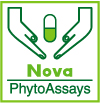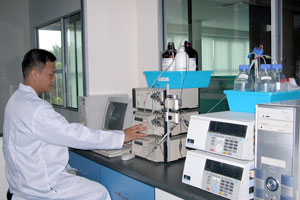ABOUT HEPAR-P™
Quality Control
Special
features of HEPAR-P™ capsule:
Standardised
Phyllanthus niruri extract EPN 797 is a complex extract,
which contains several active principals, and it is their
combined activity that might be responsible for its polyvalent
therapeutic actions, which are essential for treating
disorders of multifactorial origin.
The polyvalent action of standardised Phyllanthus niruri
extract EPN 797 depends upon combined expression of several
pharmacological actions. The various active constituents
of standardised Phyllanthus niruri extract EPN 797 would
be expected to have different pharmacological actions when
they are administered alone, as opposed to when they are
administered together with other constituents of the extract.
The total standardised Phyllanthus niruri extract EPN 797
preparation seems essential for its therapeutic indications.
And therefore no single constituent can mimic the effects
of the total extract of Phyllanthus niruri standardised
extract EPN 797. |
|
It
is the combined activity of the total extract that is therapeutically
active! |
 |
To ensure
that standardised Phyllanthus niruri extract EPN 797 produced
possesses consistent and reproducible hepatitis B virus
inhibiting and liver protective activities, we have developed
a stringent quality evaluation protocol comprises of Chemical
and Biological Standardization Methods, known as:–
Nova-PhytoAssays
Quality Control System
|
| Why
do we need to use Nova-PhytoAssays Quality Control
System? |
| This is to ensure that every capsule
of HEPAR-P produced possesses consistent:
i. Chemical composition, and
ii. Biological activities:
a) in vivo liver protective activity, and
b) in vitro HBsAg inhibitory activity.
|
|
 |
This
is a proprietary quality control protocol whereby both the
chemical composition and the biological activities of HEPAR-P™
capsule are being monitored:
Chemical
standardisation:
-
-
-
-
Biological
standardisation:
-
-
|
| Chemical
standardisation: |
1.
Qualitative fingerprinting by TLC
TLC fingerprinting is used to establish
the qualitative information of the chemical composition
in HEPAR-P capsule.
The characteristic TLC fingerprint of HEPAR-P capsule
as shown in the Diagram must exhibit the presence
of corilagin, geraniin, phyllanthin, hypophyllanthin,
brevifolin carboxylic acid, rutin, and gallic acid.
|
 |
|
| 2.
Qualitative fingerprinting by HPLC
HPLC fingerprinting is used to establish
the qualitative information of the chemical composition
in HEPAR-P capsule.
The characteristic HPLC fingerprint of HEPAR-P capsule
as shown in the Diagram must exhibit the presence
of corilagin, brevifolin carboxylic acid, rutin, and
gallic acid.
|
|
|
| 3.
Quantitative fingerprinting by HPLC to assay corilagin
The quantity of the active chemical
compound, corilagin in HEPAR-P capsule is determined
by HPLC assay.
Each capsule of HEPAR-P capsule must contain 10 mg
of corilagin as shown in the Diagram.
|
|
|
| 4.
Quantitative fingerprinting by UV spectrophotometric
method to assay total Phyllanthus flavonoids.
The quantify of the total Phyllanthus
flavonoids in HEPAR-P capsule is determined by UV
spectrophotometry assay.
Each capsule of HEPAR-P capsule must contain 45 mg
of total Phyllanthus flavonoids as shown in the Diagram.
|
 |
|
| Biological
standardisation: |
1.
In vitro biological assay to evaluate HBsAg inhibitory
activity of HEPAR-P™ capsule
Determine the in vitro
HBsAg inhibitory activity of HEPAR-P™
capsule by measuring the
binding activity of HEPAR-P™ to HBsAg.
Specification:
By using the test method described above, HEPAR-P™
must exhibit a mean % Inhibition of not less than
50% between hepatitis B virus surface antigen (HBsAg)
with antibody (HBsAb) at statistically significant
level of P ‹ 0.05

The rationale of using Nova-PhytoAssay
for quality control of HEPAR-P capsule is to ensure
that every batch of HEPAR-P manufactured has consistent
chemical compositions and relevant biological activities.
|
 |
|
| 2.
In vivo biological assay to evaluate protective effect
of HEPAR-P™ capsule
against CCl4-induced liver injury in mice
Administer orally the test solution
to at least six male ICR mice at dose of 240 mg of
HEPAR-P™ per kg body weight per day for 6 consecutive
days. A single dose of CCl4
is then adminsitered to cause liver injury in the
control and HEPAR-P treatment groups. Serum levels
of AST and ALT are measured.
Specification:
By using the test method described above, HEPAR-P™
must produce a protection Index of not less than 2.0,
and mean serum level of SGPT of the HEPAR-P™
test sample group must be significantly lower than
mean serum level of SGPT of the control group statistically
at P ‹ 0.05


Cutting-edge analytical techniques
and equipment are used to ensure that the quality of
HEPAR-P is the best in the world and also complying
to our stringent in-house specification.
|
|
|
|
|